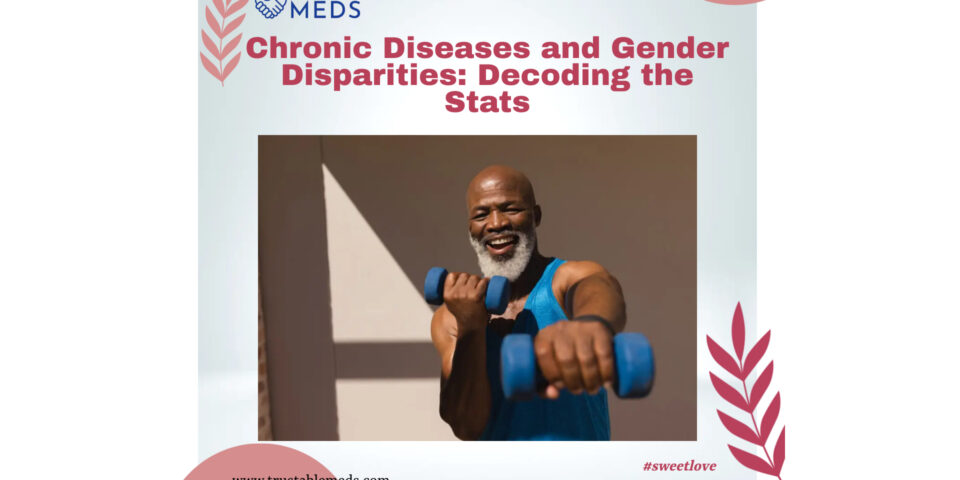Introduction
Forget dusty statistics and charts; chronic diseases and conditions aren’t just numbers on a page. They’re a hidden force silently gripping millions, and men are often caught in its grip. In this deep dive, we’ll crack the code on the alarming facts behind heart disease, cancer, and diabetes in men. Understanding why this matters isn’t just a medical question; it’s a call to action for a healthier future for all.
The Stark Reality:
Men face a brutal truth: heart disease, cancer, and diabetes stalk them with a relentless predator’s instinct. These conditions aren’t equal-opportunity threats; they disproportionately target men, leaving scars on families and communities. Ignoring this gender health gap threatens the well-being of our society.
| Worried about not meeting your partner’s desires? Eliminate erectile dysfunction with Tadalista. Buy tadalista 60 now at Trustablemeds.com and discover your full potential. |
Unraveling the Puzzle of Chronic Diseases
But why does this disparity exist? It’s a tangled web woven from biology, lifestyle choices, and the invisible threads of societal pressures. We’ll dissect each strand, peeling back the layers on:
The Heart of the Matter:
Dive into the raw statistics of heart disease in men, then explore the hidden biology, lifestyle choices, and stress factors that fuel its flames.
Our story begins with the heart, the rhythmic engine that propels life. Yet, men face a grim reality – a higher risk of succumbing to the clutches of heart disease [congestive heart failure], the world’s leading killer. The World Health Organization paints a sobering picture: men tend to succumb to congestive heart failure-related ailments years earlier than women. These stark statistics, with men accounting for a significant majority of cases, scream for an urgent understanding of the factors fueling this disparity.
Data whispers further secrets. The American Heart Association reveals that men not only experience heart attacks more frequently but also at a younger age. While genetic predispositions play their part, lifestyle choices like smoking, excessive alcohol consumption, and unhealthy diets emerge as the villainous puppeteers pulling the strings of this gender disparity.
Cancer’s Conundrum:
Unmask the gendered face of cancer, from age-specific threats to the hormonal and environmental influences that tip the scales.
As we traverse the treacherous landscape of chronic diseases, we encounter the formidable foe of cancer. The National Cancer Institute’s chilling statistics reveal a grim truth – men face a higher lifetime risk of this unwelcome intruder than women. The numbers echo a somber tale: not only are men more likely to be diagnosed with cancer, but they also have a higher mortality rate.
Lung cancer, prostate cancer, and colorectal cancer stand out as particularly poignant chapters in this gender-biased saga. Smoking rates among men fuel the flames of lung cancer, while prostate cancer remains a pervasive threat. The reasons behind these disparities are a tangled web, woven with threads of genetic factors, hormonal differences, and varied exposure to environmental carcinogens.
The Sugar Trap:
Diabetes lurks in the shadows, and men are more likely to fall prey. We’ll expose the demographics, hormonal dance, and dietary devils that contribute to this silent epidemic.
As we delve deeper into this narrative, the specter of diabetes, a metabolic disorder affecting millions globally, rises into view. Statistics, once again, echo a resounding truth – men are more prone to this foe than women. According to the International Diabetes Federation, men not only develop diabetes more frequently but are also more susceptible to its complications.
Insulin resistance, abdominal obesity, and unhealthy lifestyle choices play pivotal roles in this gender imbalance. Men’s bodies, it seems, have a proclivity towards metabolic challenges, underscoring the importance of early detection and proactive lifestyle changes.
| Experience a transformation with Vidalista 20mg – the key to overcoming erectile dysfunction. Secure your supply now from trustablemeds.com and unlock a realm of untapped potential. |
Beyond Biology of Chronic Diseases: Societal Pressures:
But health isn’t just a biological battleground. Societal expectations, access to healthcare, work-life balance, and mental health stigma all play a role in this drama. We’ll tackle:
The Stressful Script:
How societal pressures pile on the pounds of stress for men, and what they can do to rewrite the script for better mental well-being.
Healthcare’s Uneven Playing Field:
Uncover the disparities in healthcare access for men and explore solutions to level the field.
Work-Life Imbalance:
A Tightrope Walk: We’ll navigate the tightrope of work-life balance, showing men how to find their equilibrium and prioritize their health.
Breaking the Silence on Mental Health:
It’s time to silence the stigma surrounding mental health in men. We’ll encourage open conversations and highlight the positive impact of seeking help.
Taking Charge of Your Health to cure Chronic Diseases
This isn’t just a spectator sport. Men can rewrite their health narratives by:
Embracing Healthier Habits:
From dietary tweaks to stress-busting techniques, we’ll offer practical tips for incorporating healthier habits into daily life.
Prioritizing Checkups:
Regular checkups are your health allies. We’ll guide you through age-appropriate screenings for chronic diseases.
Early Detection:
Be Your Own Watchdog: Knowing the early warning signs of chronic diseases is crucial. We’ll empower you to be proactive in monitoring your health.
Mental Health Matters:
Don’t let mental health challenges take a backseat. We’ll encourage seeking professional help and highlight the resources available for support.
A Future Free from Chronic Diseases:
Bridging the gender health gap requires a future vision:
Inclusive Research:
Clinical trials and studies must reflect the diversity of the population, ensuring findings benefit all genders.
Gender-Specific Focus:
Research delving deeper into the unique health needs and concerns of men is crucial.
Policy-Driven Change:
Translating research into policies that promote health equity and address inequalities in healthcare access is essential.
Education: The Key to Equity:
Health education is a powerful weapon against Chronic Diseases. We’ll show you how to:
Boost Health Literacy:
Empower men with knowledge about chronic diseases, risk factors, and preventative measures.
Spark Open Conversations:
Normalize discussions about men’s health in communities, schools, and workplaces.
Advocate for Your Health:
Equip men to be their own health advocates, making informed decisions about their well-being.
Conclusion:
The gender disparities in chronic diseases are not mere statistics; they’re a complex story waiting to be rewritten. By understanding the characters, the plot twists, and the power of individual action, we can create a healthier future for all. So, men, take the stage, own your story, and reclaim your health. Every step you take towards a healthier you ripples outward, creating a healthier tomorrow for everyone.
Remember, you are not just a number, you are a force for change. Start your journey today!
- Q: Why is understanding the gender gap in chronic diseases important?
- A: Recognizing and addressing these disparities is crucial for promoting overall health equity, preventing premature deaths, and improving quality of life for men.
- Q: What are the main chronic diseases affecting men disproportionately?
- A: The blog focuses on heart disease, cancer, and diabetes, but other conditions like chronic respiratory diseases and mental health issues can also impact men more than women.
- Q: What are the biggest factors contributing to this gender gap?
- A: A complex interplay of biological differences, lifestyle choices, societal pressures, and healthcare access all play a role.
- Q: What are the unique risk factors for heart disease in men?
- A: Higher rates of smoking, unhealthy diets, stress, and abdominal obesity contribute to the increased risk in men.
- Q: What are the main types of cancer that affect men more than women?
- A: Lung cancer, prostate cancer, and colorectal cancer are some of the leading causes of cancer death in men.
- Q: Why are men more prone to type 2 diabetes?
- A: Men tend to have higher levels of abdominal fat and insulin resistance, making them more susceptible to the disease.



